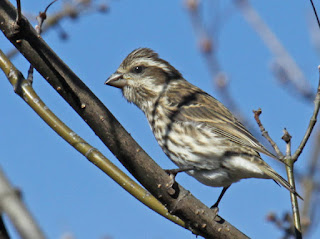 |
| female Purple Finch |
Today the familiar crunch, crunch of my shoes crushing the hackberry nipple galls attached to the now fallen yellow and brown leaves, made me look down.
 |
| Hackberry Nipple Galls |
That's when I noticed this quarter-sized irridescent beetle scurrying across the trail, disappearing in the leaf litter.
I'm not afraid of beetles, but this one looked like a mini tank, and I wondered about those reddish-orange comb-like antennae. It was moving too fast for me to photograph it on the ground, so I threw caution to the wind and picked it up.
I've never taken an entomology course, so I was clueless about how to hold one of these creatures safely (for it and me). As I was working on getting my camera readied - and holding the beetle in the palm of my hand, it flipped upside-down.
 |
| phoretic mites on an earth boring beetle |
They weren't eggs. They were moving round on that chest.
They weren't "baby" beetles. Beetles go through complete metamorposis from egg to larvae to pupae to adult.
I found the answer later when I uplinked my photos at www.bugguide.com.
They're phoretic mites. Phoresy is the term used to describe the relationship between two species where one attaches to the other for transportation. Harmless to the beetle (and me), these arthropods feed on the eggs of the flies attracted to the same food that the beetle eats. They hitch-hike on beetles to get from meal to meal.
This beetle, one of more than 600 species world-wide in the Geotrupe family, is one of the earth boring beetles. Male Geotrupes are are known for dragging decaying and moldy leaf litter, fungi and occasionally dung, into their tunnels. Then they wait for the females to show up. After copulation, the female lays her eggs on the food the male has provisioned.
So, what was this beetle doing crossing the trail?
Maybe it was checking out the leaf litter or heading to its next meal.


No comments:
Post a Comment